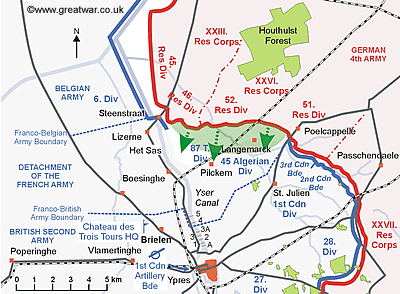 1st Brigade Canadian Field Artillery moves from the reserve
1st Brigade Canadian Field Artillery moves from the reserve
22 April 1915: 17.30
About half an hour before the German attack was launched the 1st Brigade Canadian Field Artillery (CFA) was ordered to move forward towards Ypres from its position in reserve at Vlamertinghe. The Brigade would wait near Ypres until it received further orders to move into a position near the Brielen Bridge No. 4 on the Yser Canal in the early hours of the following morning, 23rd April.
Major John McCrae, a doctor, was second in command of this artillery brigade. In his capacity as a military doctor he was also the brigade surgeon. John McCrae became famous as the author of the poem “In Flanders Fields”. It is believed that he wrote the poem ten days later on 2nd May during the battle in which he was about to become involved: the Second Battle of Ypres.

As the 1st Brigade CFA moved along the road towards Ypres French troops and refugees were streaming past them, away from the fighting line, all of them talking and shouting. According to the Brigade Commander, Lieutenant-Colonel E W B Morrison, at one point a massive crowd of French Moroccan soldiers of the 45th Algerian Division was heading towards the Canadians, who tried to cut them off; the Moroccans fell off their horses and wagons and lay writhing on the ground, foaming at the mouth.
Lieutenant-Colonel Morrison went forward to try to find out about the situation in the front line. He discovered the reason for the terrible state of the Moroccans. They had been gassed.
John McCrae's diary account of the desperate scene as he waited west of Ypres reads as follows:
“As we sat on the road, we began to see the French stragglers: men without arms, wounded men, teams, wagons, civilians, refugees - some by the roads, some across the country, all talking, shouting - the very picture of a debacle. I must say they were the 'tag enders' of a fighting line rather than the line itself. And they streamed on and shouted us scraps of not too inspiriting information - while we stood and took our medicine, and picked out gun positions in the fields in case we had to go right in there and then. The men were splendid: not a word: not a shake. And it was a terrific test. Traffic whizzed by: ambulances, transport, ammunition, supplies, despatch riders - and the shells thundered into the town or burst high in the air nearer us, and the refugees streamed. Women, old men, little children, hopeless, tearful, quiet or excited, tired, dodging the traffic - and the wounded in singles or in groups: here and there I could give a momentary help, and the ambulances picked them up as they could. So the cold, moonlight night wore on - no change save that the towers of Ypres showed up against the glare of the city burning - and the shells still sailed in.” (1)
Next>> German XXVI. Reserve Corps reaches its first objective: Pilckem Ridge
Related Links
“In Flanders Fields” poem by John McCrae
Inspiration for “In Flanders Fields”Acknowledgements
(1) A Crown of Life: The World of John McCrae, by Dianne Graves, p. 192